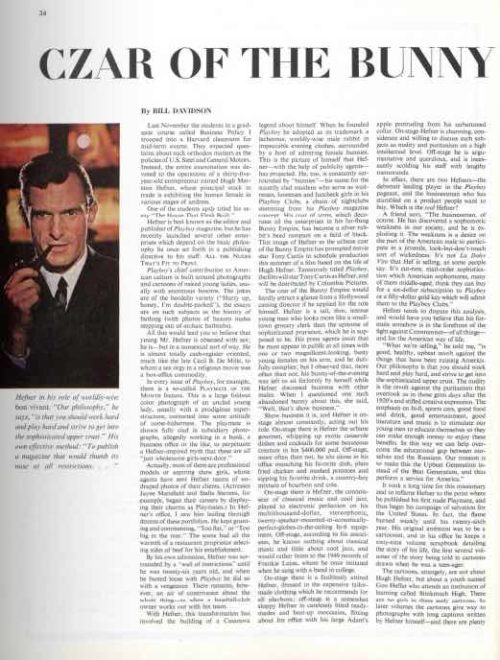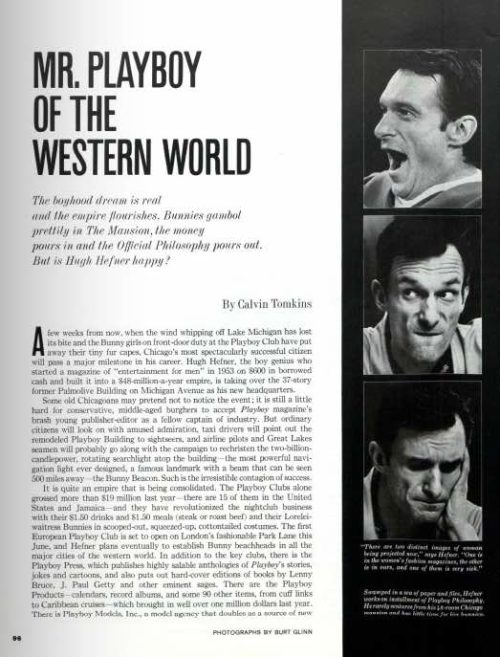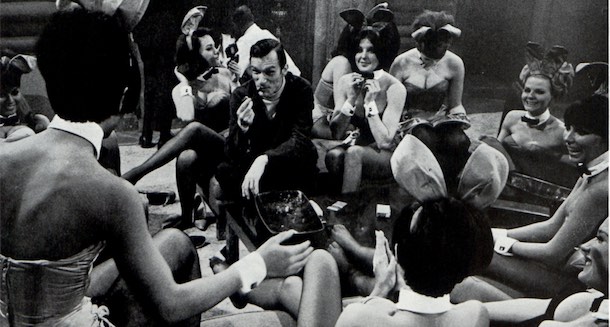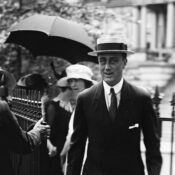Hugh Hefner, who died on September 28 at the age of 91, was profiled not once, but twice by The Saturday Evening Post. Both articles appeared in the 1960s, when Hefner had turned his upscale girlie magazine, Playboy, into a publishing empire.
In the 1940s, Hefner had worked for Esquire magazine, then considered the country’s most risqué publication. In 1953, he believed the country was ready for a far more sexually suggestive publication and started his Playboy magazine. The first issue sold unexpectedly well: over 50,000 copies, helped by the inclusion of pictures of a nude Marilyn Monroe.
By 1960, its circulation had topped one million, which is a quicker growth in circulation than even the Post achieved.
In the Post’s April 28, 1962, article, “Czar of the Bunny World,” author Bill Davidson presents Hefner as a man less obsessed with sex than with business. While Playboy portrayed him as a laid-back, sophisticated, jazz-loving epicure, Hefner was in reality a magazine geek and workaholic:
Hefner works at his legend 18 hours a day. He rises about one p.m., goes to his office to berate and guide his Playboy staff, and generally spends his evenings escorting celebrities around his Chicago Playboy Club. He never takes a vacation.
Davidson described him as looking “more like a small town grocery clerk than the epitome of sophisticated prurience.”
Hefner’s character was just one aspect of the Playboy impression. The magazine also liked to present itself as the champion of liberty and the American way during the Cold War. Hefner’s column, “The Playboy Philosophy,” featured “a seemingly endless crusade against censorship, obscenity laws, sexual repression and American puritanism in general.” But that message would have had less market appeal without the nudity customers expected.
Four years later, the Post reported on Hefner again. The Playboy empire had continued to grow: The clubs were grossing over $19 million a year, and annual magazine sales exceeded $28 million.
Calvin Tompkins’ article from April 23, 1966, “Mr. Playboy of the Western World,” focused more on Hefner’s rise from obscurity, his repressed childhood, and his crusade against censorship and repression. Tomkins’ impression of Hefner and his empire differed little from Davidson’s:
Hefner has lost interest in parties. He works around the clock, sometimes 30 or 40 hours at a stretch, eating when he remembers to, drinking bottle after bottle of soda pop, going to bed only when he is ready to drop from exhaustion, sleeping like a baby for eight or nine hours and then getting up and starting over again.
Tomkins saw the publisher as a man in arrested development who wanted the image of success more than its substance. “Success,” Hefner told him “has to do with how close you come to the ideas you had as a child.”
Hefner vociferously defended the use of nude or nearly nude women in his magazine and clubs. Tomkins wrote, “To the frequent accusations that this is a puerile and insulting attitude that reduces women to the status of a commodity, Hefner invariably replies that such criticism simply reveals the critic as having a ‘sexual hang-up’ of some sort, a pathological bias against healthy sex.” But Hefner’s statements about women differed from the daily reality at Playboy. A local newsman commented, “In the Playboy world, a female goes into the discard when she is not the show-girl type, when she has a bust of less than 38 inches, when she reaches the age of 25, and when she exhibits any intelligence.” And an executive in the corporation told Davidson, “I guess we do express an antifeminist point of view, and we might be somewhat in error in not giving the exceptional woman full credit. But we firmly believe that women are not equal to men.”
Despite the glitzy mansions, beautiful women, and glossy magazine that Hefner worked so hard to build, the true nature of the man was likely something far different. Said a friend, “I have a feeling that when he’s all alone, there in the stillness of the night, that’s when he’s the happiest.”


Become a Saturday Evening Post member and enjoy unlimited access. Subscribe now




Comments
Marilyn Monroe – first centerfold
Of the new Playboy magazine.
The nude picture, the tale was told,
Was young Monroe, new on the scene.
Five hundred bucks Hefner did pay
The nude calendar company.
Monroe, not paid, went on display
To become published history.
Hefner and Monroe never met.
He talked to her once on the phone.
An issue copy she did get,
But had to buy it on her own.
Next door crypts of the dead elite.
Monroe and Hefner at last meet.
Very few things in life are what they appear. We all know this to be especially true in the worlds of sports and entertainment. Hugh Hefner was in show business as much, if not more than some of the biggest male movie stars.
I read (and commented) on John Wayne’s woes just yesterday from a 1962 feature. Hugh Hefner was his own product as much as Playboy. He HAD to project the image of BEING that Playboy himself, to SELL the fantasy to millions of men over several decades. He and Playboy were intertwined, and there was no getting around it.
As the empire grew and grew, the more pressure there was to keep the studly fantasy growing as well. It was a dual role he played. The image on ‘stage’ and the workaholic businessman who had to stay on top of business, far more than (on top) of any women. VERY long work hours and the constant exhaustion take their toll.
This is not to say Hef didn’t have his fair share of the ladies over the years, but may have been a lot more monogamous than we might think. Barbie Benton was pretty much his ‘wife’ for about 10 years. I think she provided stability and real love. She was always one of my favorites; a true beauty.
The magazine has been kind of a mess the past few years in it’s look, format, etc. which has become this weird hybrid of (say) Maxim, Details and Wired magazines. The nudity was gone last year, but returned this year. It doesn’t make any difference at this late date. I won’t be subscribing again—sorry.
The image of him as being a male chauvinist was a lot less so than a lot of women (or men) might have imagined. Kind of like Playboy telling men they can ‘have it all’, you had Helen Gurley Brown telling women the same thing. In the mid-70’s there was a commercial for a perfume called ‘Enjoli’ The 8 Hour Perfume for the 24 hour woman!
Even in these very messed up times, some common sense prevails in less pressure on BOTH sexes to ‘have it all’. Tolerated in the ’70s, the reaction would be more like “are you for real” and “what planet are YOU on” from both sexes. In closing I gotta say the Post kicked ass in the ’60s with their exclusives such as these!